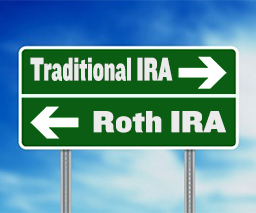If you’re someone who does their own taxes through a program like Turbo Tax, you’ve probably run into this scenario: as you finish up the review portion, the program will remind you that there may be a way for you to lower your tax burden even more if you make a deductible contribution to an IRA account. They even have a helpful calculator you can use to see what impact certain contribution amounts would make on the taxes you owe.
The program brings this up because of a little quirk in the contribution laws when it comes to IRAs – individuals actually have until the tax filing deadline to make a contribution that will count towards the prior year. So for tax year 2015, you have until April 18, 2016 to make a prior year contribution to your IRA.
The contribution rule applies to all IRAs, both Traditional and Roth. Which brings me to my question – which is better to fund, a Traditional or Roth IRA? Programs like Turbo Tax are recommending ways to immediately reduce your taxable income, which a contribution to a Traditional IRA could do. However, though a Roth has no immediate tax reduction benefit, it may be best for you in the long run, as future distributions from the account come to you tax free.
For me, having money in both types of accounts provides the best of both worlds when it eventually comes down to planning your retirement income. To make sure you’re better informed about your options, below is a brief breakdown of the differences between a Traditional and Roth IRA:
Traditional IRA
With a traditional IRA, you contribute money on a tax-free basis, provided that you meet certain IRS criteria. This means that your contribution may be deductible from your income and, if so, it reduces your tax burden immediately. For 2016, the contribution limit for a traditional IRA is $5,500 for those under 50 and $6,500 for those aged 50 and older.
You’re free to start taking withdrawals from your IRA once you reach age 59 ½, at which point you’ll pay ordinary income taxes on them. If you access those funds before you hit 59 ½, you’ll be liable for a 10% penalty on whatever amount you withdraw. Furthermore, when you reach the age of 70 ½ the IRS requires that you take an annual minimum distribution from your IRA. Should you fail to take this distribution, you can be assessed a 50% penalty on whatever required amount you failed to take out.
Roth IRA
A Roth IRA works similarly to a traditional IRA, but the main difference is that your contributions are not made on a tax-free basis. Rather, you’ll pay taxes up front on what you put in, but when you start taking withdrawals in retirement, those distributions will be tax-free.
There are 2 ways to fund a Roth IRA:
- You can convert a Traditional IRA or other qualified retirement plan (i.e. 401(k), 403(b), etc.) into a Roth account. There are no income limitations or contribution limits when it comes to funding a Roth IRA with a conversion, though you will owe taxes on the value converted.
- You make a direct contribution. The contribution limits for a Roth IRA are the same as those of a traditional IRA, but if you earn too much, you may be deemed ineligible to contribute. For 2016, single tax filers earning $132,000 or more are ineligible for a Roth IRA; those who are married, file jointly, and earn $194,000 or more are ineligible as well.
Roth IRA withdrawals
If you hold a Roth, you can start taking penalty- and tax-free distributions once you reach age 59 ½, provided that the money has been in your IRA for at least five years. There are a couple other additional differences for Roth distributions:
- For a Roth IRA funded through direct contributions, if you make withdrawals prior to age 59 ½, you’ll pay a 10% penalty on your earnings, but not on your original contributions.
For example, let’s say that over the course of a five-year period, you’ve contributed $2,000 a year to your Roth IRA for a total of $10,000, and your current balance is $14,000 because your contributions have generated an investment return. Now let’s assume you’re not yet 59 ½, but want to withdraw some money nonetheless. If you withdraw just $10,000, you won’t be taxed or penalized. If you withdraw the full $14,000, then you’ll be subject to taxes and penalties on the $4,000 you didn’t contribute directly.
- Converted funds are treated a little differently; in order to take tax-free distributions of converted amounts, you’ll need to wait five years from the conversion date to withdraw money. Penalties will also still apply to any earnings withdrawn if under age 59 ½.
- Finally, an annual minimum distribution is not required from a Roth IRA.
One last note: All contributions to IRAs are aggregated together, and must not be more than the maximum contribution limit of $5,500 (or $6,500 if you are age 50 and over). So if you have both a Roth and a Traditional IRA, your contribution to both cannot be more than this.
